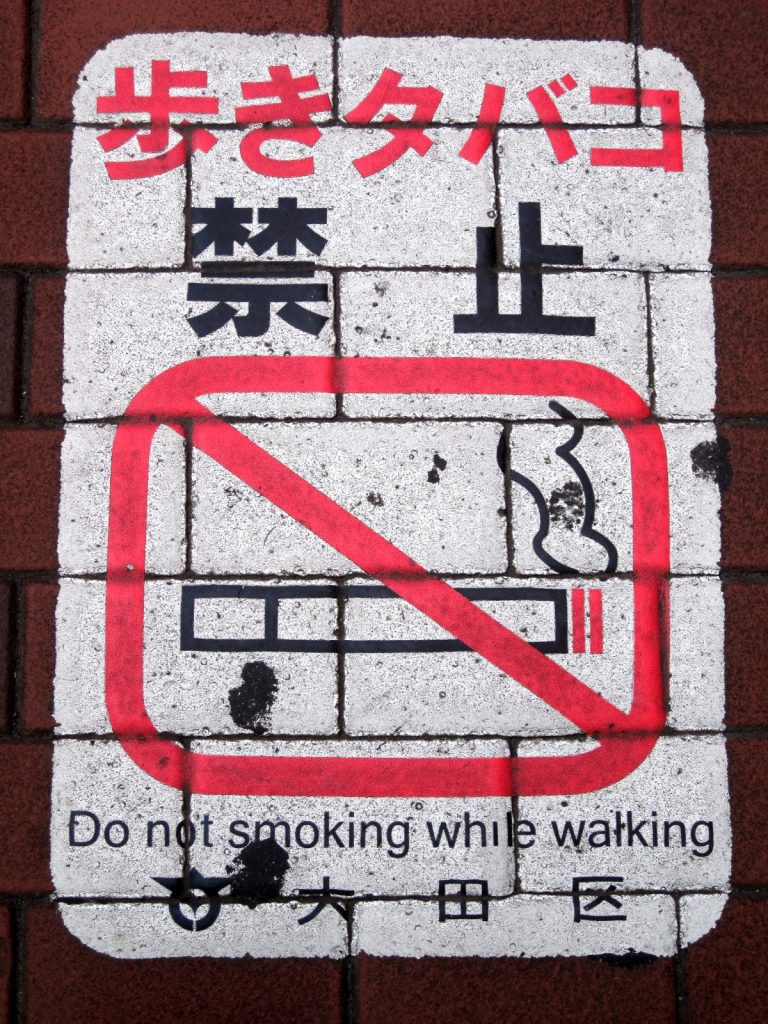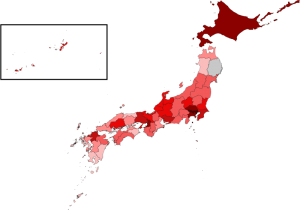Smoking in Japan

According to 2019 data, Japanese smoking rates are at an all time low, but still high relative to countries with similar GDP. Currently around 25% of men and 15% of women still smoke.
The reality on the ground is that in the last 10 years, the cost of a packet of cigarettes has doubled due to tax hikes, the number of restrictions on smoking has increased and very recently further laws will come into affect just in time for the 2020 Olympics that aims to clean up public spaces. Coming to Japan 10 years ago I was surprised by the lack of smoking outside while inside everyone was still lighting up. It seems the ban outside was more to do with litter and accidentally burning people than public health (a campaign a few years ago produced some awesomely Japanese posters – more here).
There is criticism that the laws for 2020 are “watered down” due to exemptions for small bars where segregation is not possible. Push-back from these establishments point to the high smoking rate especially among males, who are the customer base of these small businesses. However, a far more stringent ban enacted in the UK in 2007 did not significantly increase the natural decline and was introduced at a time when males smoked as similar rates to Japan today (roughly 22% in the UK in 2007 vs 25% for Japan today).
Can a European style ban work in Japan?
Of course, there are unique problems for Japan. The first is the lack of outside space to construct smoking areas. 10s of small bars are quite often packed into multi-story buildings, with each bar only able to handle 5-10 customers at one time. Asking them to segregate is impossible, as is creating a smoking facility outside (no space and smoking on the street is already forbidden). A smoking room could be made inside the building but it would have to consume an area already taken by a tenant and at the very least would be shared by all businesses (allowing your customers to mingle with the competition?). UK pubs and restaurants tend to be larger and smoking outside is not a problem.

“When it gets too costly, I’ll quit”
No one in Japan seems particularly resistant to the idea of smoking being on the decline. “I’ll quit when it becomes too expensive” is a frequent comment from smokes asked if they will every stop. No-smoking in offices is already the norm, with smoking rooms common at major companies (popping to the nearest convenience store to smoke is also common – but not one too close to the office just in case you get caught). There are sometimes no-smoking days although these policies are often ceremonial, especially if senior managers still smoke (more likely due to age).
Health concerns seem less common in Japan, perhaps because of the relatively low rates of cancer compared to the west. The reasons are numerous however the annual checkup many Japanese receive via their company health insurance is surely a factor, with 20% of lung cancer diagnosis coming from the annual x-ray.
Vaping in Japan
Vaping has only just taken off in Japan with the number of vape shops increasing and vaping gear being sold at convenience stores. Vaping is now treated just like smoking but numbers seem to have peaked already, probably holding steady due to the number of people quitting smoking altogether.

Overreaction or just about enough?
In general, the measures taken up to the 2020 Olympics seem to strike a good balance between the needs of non-smokers and families, with the reality that most small businesses are not a place for children anyway. It seems much better to give society a nudge with legislation and let the market take care of the rest. As has been shown in the UK, the rate of smoking has only really been affected by the cost and health concerns, with perhaps education level and GDP also factors on the worldwide stage. Access and convenience doesn’t seem to be a factor.


